FESTIVALS (Matsuri)
Index: Mikoshi,
Cherry Blossom Viewing, Setsubun, White Day, Stupid Holidays,The
Japan International Birdman Rally, Danjiri,
Hakata Gion Yamakasa, The
Shiritsumi 'Rump-Bumping Festival',
Onbashira, Kanamara Penis Festival,
Kenka Mikoshi, Tagata Jinja Hounen
Penis Festival, Hadaka (Naked) Festival,
The Hari Kuyo Pin Festival,
Tezutsuhanabi Fireworks Festival, Hamamatsu Kite
Festival, Takeuchi Festival
One of the best things about Japan is how pagan and other-worldly it can be. You
really know that you're not in Kansas anymore when you go to a festival and
there are thousands of half-naked people dancing and beating wildly on drums,
huge portable shrines covered in graven images are being pulled through the
streets, and six of the Ten Commandments are being broken right in front of your
eyes. You see things here that would send a God-fearing Christian into
convulsions: people bowing down before heathen idols, shrines that house
millions of individual gods, and giant phalluses being paraded through the
streets in front of crowds of women and children.
Festivals are a wonderful chance to see a Japan that has largely disappeared and
everyone should take the opportunity to go and see some of these odd and unusual
reminders of the past.
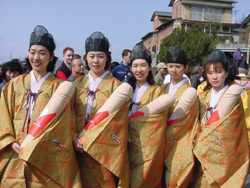 DANJIRI
- It may not quite have the body count of the Running of the Bulls in Pamplona,
but Osaka’s Danjiri festival will definitely give you what you’re looking for if
you’re an adrenalin junkie. There are broken bones and crashes most every year,
and deaths are not unheard of. The idea is to take a giant, unwieldy float, and
get a team of drunken men to pull it through Osaka’s narrow streets at
ridiculous speeds.
DANJIRI
- It may not quite have the body count of the Running of the Bulls in Pamplona,
but Osaka’s Danjiri festival will definitely give you what you’re looking for if
you’re an adrenalin junkie. There are broken bones and crashes most every year,
and deaths are not unheard of. The idea is to take a giant, unwieldy float, and
get a team of drunken men to pull it through Osaka’s narrow streets at
ridiculous speeds.
Held on September 14th and 15th, the Danjiri festival is said to have originated
in 1703 and started as a harvest festival. The floats are intricately carved
with scenes from famous battles and there are 30 different Danjiri (floats),
each one is owned by a different neighborhood. On the fourteenth, they are
pulled around the neighborhoods relatively slowly, but if two teams happen to
run into one another, the floats are rammed into one another and things can get
very rough. On the fifteenth, the floats are taken along the same routes, but
this time, the idea is to see how fast the course can be done. The floats weigh
about four tons, can be as tall as four meters, and have a very high center of
gravity, making them extremely difficult to control on the corners. As if
pulling the floats wasn’t dangerous enough, there are always three or four
people riding on the top of them like they’re surfing. Attend this festival and
you’ll never see Kyoto’s stately Gion Matsuri the same way again.
HAKATA GION YAMAKASA
– Held in Fukuoka city, Kyushu, this dangerous festival is similar to
Osaka’s Danjiri festival. In the Fukuoka version, the floats are even larger,
and there is a race along a five kilometer course. You’ll have to get up early
for this one, though, because it starts at precisely 4:59am. The festival runs
from July 1st to 15th, with the race on the last day.
SHIRITSUMI - The ‘Rump-bumping’ festival is held
in the small resort town of Ito Onsen in the Izu Peninsula on November 10th at
the Otonashi shrine. The event is also known as the Oshiri Sumo Taikai (Rear End
Sumo Competition). Participants stand back to back on an upturned wooden tub
about a meter in diameter and try to push each other off using only their bums.
THE ONBASHIRA FESTIVAL
- This ridiculously dangerous festival is only held every six years, and with
good reason. It involves thirty or forty people sitting on a log, and plummeting
down a steep slope. The logs can be more than 15 meters long, and weigh well
over ten tons. If you see an Onbashiri festival without injuries or deaths,
you’ve been cheated. The festival is held in Suwa city, Nagano, and the next one
will be held in April 2004. The festival is incredibly popular and attracted
about two million people the last time it was held in 2004, so it’s probably not
too early to start thinking about making reservations if you want to see it. The
festival is actually divided into two sections. Be careful that you don’t go to
the May version as all you will see is a bunch of logs being raised up into the
air.
Note: I saw this festival on TV and it turned out
to be really boring. The logs never seemed to go very far or very fast, and most
of the participants fell off after just a few meters. I also got this email:
Onbashira festival sounded like a once in a lifetime experience.....an almost
2000 year old festival held only once every 7 years with mad Shinto
warriors sliding down great mountains on enormous logs up in Nagano which I love
so much for the snowboarding.
The train trip there took four hours (the express is still 2 1/2 and costs 3
times as much), the walk to the muddy slope took an hour uphill through
throngs of people, the waiting for the log to arrive took 3 hours in the blazing
sun and the log sliding down the "hill" took all of 15 seconds.
It was definetly a once in a lifetime experience...watch it on TV but DONT
GO!!!!! Its simply not worth the effort.
Hamish Scott...ex-keen festival attendee
KANAMARA MATSURI
- Held every April 15th at Wakamiya Hachimangu Shrine in Kawasaki
Japan, this festival is about as wild and pagan as they get. People of all ages
participate in a parade in which most of the participants sport a gigantic
penis, and a giant lingam is carried through the streets. Females ride a
penis-shaped seesaw, and men, women and children get their picture taken
embracing a phallic statue. You can also buy penis shaped candies, or dress up
as your favorite cartoon character with one part of his anatomy dramatically
enlarged. The whole thing is presided over by a priest, and arcane Shinto
rituals are carried out as well.
The festival is said to celebrate the vanquishing of a demon that lived in a
woman's vagina and would bite off the penises of her lovers! According to
legend, a local craftsman fashioned a steel phallus which broke the demon's
teeth. In the Edo period courtesans would come to pray for good business and
protection from sexually transmitted diseases and today it is used to promote
AIDS awareness and safe sex. The Kanamara festival is held at Kawasaki Daishi
Station on the Keihin Daishi in the beginning of April.
If you would like to see a great free video of the Kanamara festival visit TokyoDV.com, a site
featuring amateur videos from Japan. You can see the penis festival, rock
bands and goths in Inokashiro park, or the cheesy graduation ceremony of a kimono school.
There's a lot of hilarious stuff here. The URL is: http://www.tokyodv.com/.
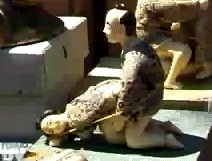
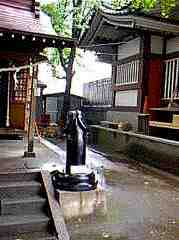
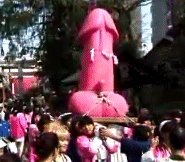
(Pictures courtesy of Tokyo DV.COM)
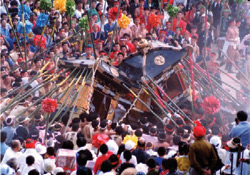 KENKA
MIKOSHI - Sometimes Japanese gods get lonely and bored sitting
all alone in their shrines. That's why local neighborhood residents like to take
their local kami for a little stroll around the neighborhood in a Mikoshi
(portable shrine) once or twice a year. These festivals are among the most
colourful and exciting in Japan and every summer, from Hokkaido to Kyushu you
will see events where people carry huge Mikoshi through their neighborhoods for
hours on end. It takes a team of 50 to
100 people, working in shifts of 30 to 50 to carry a Mikoshi, which can weigh several
tons. After the festival, most of the participants sport huge welts and bruises on
their shoulders that take weeks to heal, but people who carry Mikoshi always claim
that, despite the anguished expressions on their faces, they are having fun.
KENKA
MIKOSHI - Sometimes Japanese gods get lonely and bored sitting
all alone in their shrines. That's why local neighborhood residents like to take
their local kami for a little stroll around the neighborhood in a Mikoshi
(portable shrine) once or twice a year. These festivals are among the most
colourful and exciting in Japan and every summer, from Hokkaido to Kyushu you
will see events where people carry huge Mikoshi through their neighborhoods for
hours on end. It takes a team of 50 to
100 people, working in shifts of 30 to 50 to carry a Mikoshi, which can weigh several
tons. After the festival, most of the participants sport huge welts and bruises on
their shoulders that take weeks to heal, but people who carry Mikoshi always claim
that, despite the anguished expressions on their faces, they are having fun.
Carrying Mikoshi
is a uniquely Japanese activity, emphasizing harmony and group action. As the people
walk, they bounce the Mikoshi up and down while chanting. If one person is
out of step it makes it difficult for the rest of the people, so it takes a great deal of
teamwork and synchronization to move these heavy and unwieldy objects. The
most famous Mikoshi festival is called
Sanja Matsuri. It is held every year on the third Saturday and Sunday in May
at the Asakusa Kannon Temple in Tokyo. (Take the Ginza Subway Line to Asakusa
station and follow the crowds.) It features more than 100 Mikoshi every year,
and the crowds can be so thick that it is impossible to move. Other famous Mikoshi festivals
include the Kanda Matsuri (with 70 Mikoshi on May 15th at the Kanda Jinja Shrine in Tokyo
near Kanda station), and the Sanno Matsuri from June 10-16th at the Hie-jinja in
Chiyoda-ku, Tokyo. There is a Mikoshi festival somewhere in
Japan every weekend throughout the summer. If you are interested, check magazines
like the Tokyo Journal for details.Mikoshi festivals are
exciting, but several communities in Japan have come up with an interesting and
exciting variation of the traditional versions, the Kenka Mikoshi (fighting
Mikoshi). In these events, the participants try to destroy the opposing side’s
shrine. At the Nada Kenka Matsuri (Nada Fighting Festival) they use bamboo poles
(and sometimes kicks). At others, such as the festivals in Obihiro, Hokkaido
(mid August), Imari, Saga (October 24) or Itoigawa, Niigata (April 10), they ram
their shrines into each other, until one or the other is completely destroyed
(this is not a religious ceremony--the gods are not 'present' in the Mikoshi).
Between 'rounds', the Mikoshi are often tipped on their ends and participants
climb up the poles that are used to carry them and the Mikoshi are spun around
while the men perform acrobatics. These festivals can get very rough and
tramplings are not uncommon.
TAGATA-JINJA HOUNEN MATSURI
- In this festival, a large wooden phallus is carried around on a mikoshi.
The penis is eight feet long and weighs a thousand pounds. During the
festival, you can eat penis shaped candy, touch phalluses for good luck, and drink free
sake. If you visit the shrine, you will see that the walls of the shrine are lined
with phalluses. There is a vagina festival one week later. It is held on March
15th at the Tagata-jinja Shrine in Komaki city, Aichi prefecture. The shrine's
address is Tagata-cho 152. To learn more about the festival, visit: http://www.whatsgoingon.com/100things/tagata/
or http://www.mindspring.com/~peterthoeny/tagata/index.htm
HADAKA MATSURI -
Although Hadaka Matsuri means ‘Naked Festival’, the participants aren’t strictly
nude because everyone wears loin cloths. The most famous one is held at Konomiya
Shrine in Inazawa, Aichi Prefecture on February 17th every year. In this bizarre
festival, participants pursue a Shin-otoko, or "Naked Man" through the streets,
trying to touch him as he passes by. The “Naked man”, is a sort of scapegoat,
who absorbs evil and is said to bring good luck to anyone who comes in contact
with him. This festival is over 1200 years old, attracts more than 10,000
participants and is seen by some 300,000 spectators every year. Most of the
participants drink heavily during the event and there are a lot of injuries. For more information visit: http://www.whatsgoingon.com/coolest/place/20000217
or call: 587-32-1111
There is also a Hadaka-matsuri on Jan 14 in Kyoto at Hino Hokai-ji temple. In
this festival, a loin-clothed wearing mob chants and according to the festivals
organizers, ‘rub against one another’, whatever that means. In the Hadaka-matsuri
in Okayama city on February 3, hundreds of youth in loin cloths in outer temple
hall, try to catch phallic talisman tossed by priests.
THE JAPAN INTERNATIONAL
BIRDMAN RALLY - If you’re going to be in the Kyoto area during the last
weekend in July, don't miss this incredible event held at Lake Biwa every year.
It's one of the most exciting and unusual competitions you will ever see. The
contestants, mainly students from Japanese universities and engineers from big
companies, compete to see who can build the best HPV (human powered vehicle).
Entrants spend months designing and building their aircraft, and then climb up
on a ten-meter-high platform to test them out. Some of the craft sail
majestically over Lake Biwa for many kilometers, while others plunge straight
into the water.
The aircraft are aeronautical wonders built from super-light carbon fiber and
plastics. The 1992 winner, the Gokuraku Tombo (Super-Happy Dragonfly), which set
a record of 23 kilometers had a wingspan of 32 meters, yet weighed just 32 kg!
There are three categories: Human Powered Aircraft, Gliders, and the "Challenge
category", where the look and artistry of the aircraft are more important than
the distance flown. The Birdman Rally is held on Matsubara beach on the shores
of Lake Biwa. Lake Biwa is in Hikone City, Shiga Prefecture, only about an hour
by train from Kyoto.
HARI
KUYO - Memorial services for old needles and pins are held in late
January and early February every year. A memorial service for pins and needles
may seem a little odd, but in the days before mass production, these simple
objects were among a woman’s most important possessions. A pan of tofu is laid
out, and all the broken and bent needles are put into it while prayers are
recited. The tofu is then wrapped in paper and the needles are floated down a
river or out to sea. Some of the more famous versions of this ritual can be seen
in Tokyo at Shojuin Temple near Shinjuku Gyoen-mae station, Shinganji Temple
near Shimokitazawa Station (Tokyo), and Sensoji Temple in Asakusa.
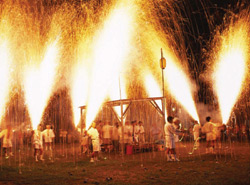 TEZUTSUHANABI
– This is a fireworks festival with a twist. Instead of shooting off the
pyrotechnics from a safe distance, these brave souls hold onto the launchers
with their bare hands. And yes, they do get burned. Festival participants
proudly show off the scars from their burns which cover more and more of their
torsos every time they participate in the festival.
TEZUTSUHANABI
– This is a fireworks festival with a twist. Instead of shooting off the
pyrotechnics from a safe distance, these brave souls hold onto the launchers
with their bare hands. And yes, they do get burned. Festival participants
proudly show off the scars from their burns which cover more and more of their
torsos every time they participate in the festival.
HAMAMATSU MATSURI - Japanese kites are unique in the
world, and some are as beautiful as anything you will see in the art museums.
During the Hamamatsu Matsuri, which will be held from May 3rd to 5th this year,
more than 150 teams compete in a spectacular ‘Kite Fighting’ competition in
which giant kites are flown in a battle to cut the strings of the other teams’
kites. The kites are as large as three to five meters per side, and many of the
teams spend the better part of a year making them and preparing for the
festival. Hamamatsu is located in Shizuoka prefecture.
TAKEUCHI MATSURI - More of a
street fight than a festival, the Takeuchi Matsuri is one of the most rough and
tumble events in Japan. Every year on February 15th, people in the town of
Rokugo, in Akita prefecture divide themselves into two teams and whack each
other with long bamboo poles. The sight of hundreds of helmeted men hitting each
over the head with bamboo poles is one of those 'only in Japan things' and if
you're curious to see it, check out
http://www.akitafan.com/movie/ (the link is the second one from the top on
the left side). What you don't usually hear about in descriptions of the
festivals, is how violent and dangerous it is. The first and second rounds are
three minutes each, and are limited to fighting with the bamboo poles, but the
third round is apparently and anything goes free-for-all where participants are
more interested in punching and kicking each other than they are in the bamboo
poles. You can read a very graphic description of one English teacher's
experience at the festival at:
http://andmisadventuresof.blogspot.com/2005_02_13_andmisadventuresof_archive.html.
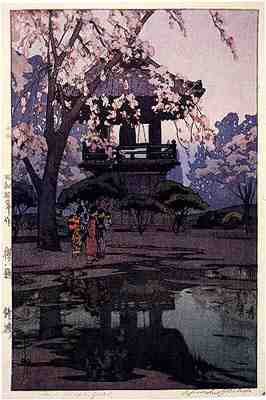 HANAMI (CHERRY BLOSSOM VIEWING):
HANAMI (CHERRY BLOSSOM VIEWING):
Innocence...
Perhaps you have an image of a Cherry Blossom Viewing Party in your mind :
Men and women clad in gaily coloured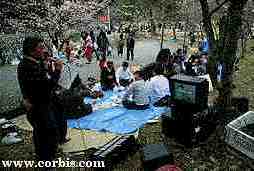 kimono
sitting under
the pink
blossoms, laughing happily, sipping sake and reciting poetry. The
gorgeous pink blossoms blown by the wind cascade softly to the ground, causing
the celebrants to meditate on the beauty and ephemerality of life.
kimono
sitting under
the pink
blossoms, laughing happily, sipping sake and reciting poetry. The
gorgeous pink blossoms blown by the wind cascade softly to the ground, causing
the celebrants to meditate on the beauty and ephemerality of life.
and experience...
The reality: Thousands of salarimen and office ladies sprawled
drunkenly on ugly blue plastic mats. There are mountains of reeking garbage
everywhere, portable karaoke machines play J-Pop at ear-splitting
levels, and when you walk you have to be careful not to trip over the people
passed out in a pool of their own vomit. Ueno Park in Tokyo, though
renowned for its beautiful cherry trees, is one of the ugliest places in the
world during cherry blossom season.
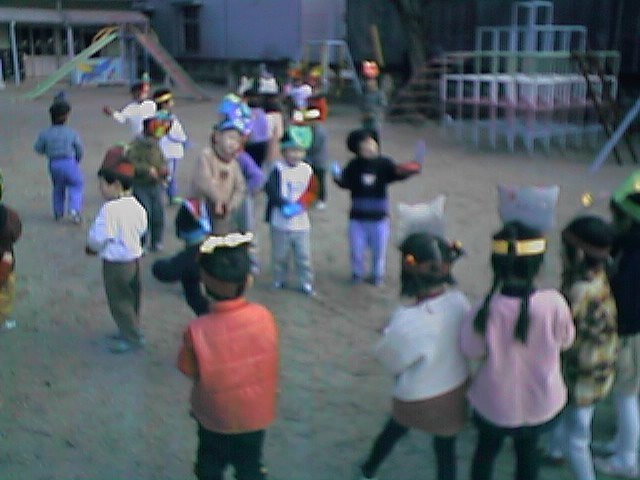 QUIRKY HOLIDAYS
QUIRKY HOLIDAYS
Setsubun (Bean-Throwing Festival)--If you walked
around your house throwing beans into the street and shouting "Good luck come
in. Devils get out! (Fuku wa uchi! Onni wa soto!)" anywhere else in the
world, you would probably be taken to the laughing academy, but in Japan, millions of
people celebrate this extremely quirky festival every year. By the old Japanese
lunar calendar, the end of winter comes on February second
or third, so to ensure that
there were no devils or demons lurking around their homes, people threw beans to scare
them off. Apparently beans are a symbol of the impregnation of the earth and
therefore scare demons. Setsubun nowadays is mostly for children, who have a
great deal of fun shouting and tossing beans at imaginary demons.
White Day
It's the world's first
corporate holiday. Japan's department stores and confectioneries decided that they
weren't selling enough Chocolate on Valentine's day, so they went out and invented a
second opportunity to sell sweets. In Japan, the custom is for women to give
chocolate to their lovers or men that they want to date, so some years ago, the department
stores started selling chocolate for White Day, which falls on March 14th, a month after
Valentine's. On this day, men are expected to reciprocate for the gifts they
received in February.
In Japan, there is also a thing
called Girichoco (obligation chocolate). On Valentine's day, women are not
just expected to give chocolate to their significant other. They are expected to
give something to all of their co-workers as well, and any man who is given Girichoco
on Valentine's day, is expected to reciprocate on White Day.
Click here to return to the MAIN PAGE.

 DANJIRI
- It may not quite have the body count of the Running of the Bulls in Pamplona,
but Osaka’s Danjiri festival will definitely give you what you’re looking for if
you’re an adrenalin junkie. There are broken bones and crashes most every year,
and deaths are not unheard of. The idea is to take a giant, unwieldy float, and
get a team of drunken men to pull it through Osaka’s narrow streets at
ridiculous speeds.
DANJIRI
- It may not quite have the body count of the Running of the Bulls in Pamplona,
but Osaka’s Danjiri festival will definitely give you what you’re looking for if
you’re an adrenalin junkie. There are broken bones and crashes most every year,
and deaths are not unheard of. The idea is to take a giant, unwieldy float, and
get a team of drunken men to pull it through Osaka’s narrow streets at
ridiculous speeds. 





 kimono
sitting under
the pink
blossoms, laughing happily, sipping sake and reciting poetry. The
gorgeous pink blossoms blown by the wind cascade softly to the ground, causing
the celebrants to meditate on the beauty and ephemerality of life.
kimono
sitting under
the pink
blossoms, laughing happily, sipping sake and reciting poetry. The
gorgeous pink blossoms blown by the wind cascade softly to the ground, causing
the celebrants to meditate on the beauty and ephemerality of life. QUIRKY HOLIDAYS
QUIRKY HOLIDAYS